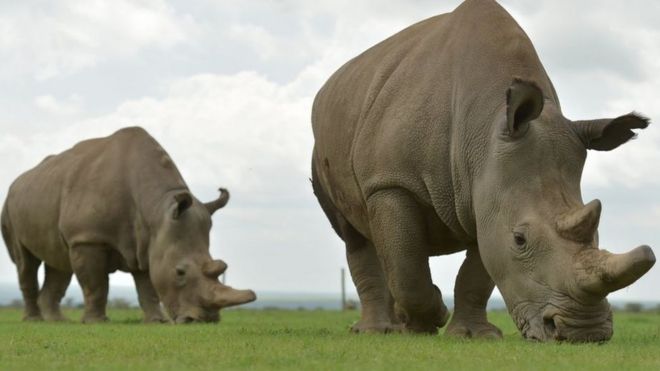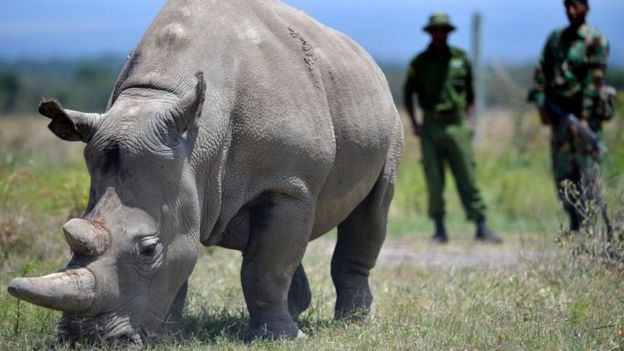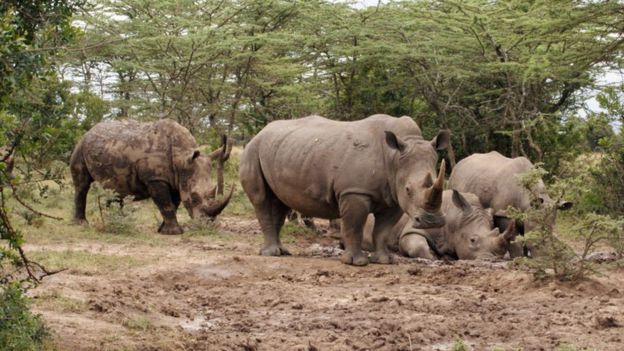Concept of the “Rhino Named Sudan” Collection
The life story of the northern white rhino named Sudan inspired us to design a collection called “Sudan” to support the preservation of this species of rhino.

The future of the northern white rhino is bleak. There are only two female northern white rhinos left in the world, but scientists are making a bold plan to save the species from extinction.
When I went to see the rhinos in Kenya, they circled around the car. I was a little scared when James Emonda, the animal caretaker, opened the car door.
“Can we get out of the car?” I asked.
“Yes, they are calm,” he reassured me.
But I was not so calm when one of the rhinos came towards me. I was hiding behind the car when Mr. Emonda said that the rhinos were not afraid of humans; this did not reduce my fear of rhinos.
The rhino, named Najin, is domesticated because he was brought from a zoo in the Czech Republic. The animal now lives in a large enclosure in the Ol Pejeta Game Reserve in central Kenya.

In 2009, he was one of four rhinos (two females and two males) brought to Kenya from a zoo in the Czech Republic in an attempt to breed. The zoo had been unable to get them to reproduce.
At the time, it was thought that if the rhinos were returned to their natural environment, they would probably breed. But that didn’t happen. The rhinos mated, but Najin and his daughter Fatu never had children.
Then two males died. First, Sunny, a 34-year-old rhino, died of natural causes in 2014. Four years later, Sudan, a 45-year-old rhino, died of non-healing skin wounds. He had a disease that destroyed his joints and bones.
Now Najin and Fatu are the last remaining northern white rhinos in the world, and neither is pregnant.
Precious sperm
But this situation has not stopped scientists around the world from trying to save the species, and now they have resorted to a special tactic.
The story involves using preserved sperm taken from Sani, Sudan, and a chain (a unit of rhinoceros counting) of a male animal that died before them.
This sperm was taken to artificially inseminate female animals, including the southern white rhino.
There are two subspecies of white rhino in Africa: the northern white rhino, which is in danger of extinction, and the southern white rhino, which is in better shape.
However, the attempt at artificial insemination failed.
So the scientists changed the plan and tried to create an embryo (an egg fertilized with sperm) in the laboratory. This presented them with another challenge: how to get the eggs?
It was very difficult for the veterinarians who were in charge of the project to reach the ovaries of the female animal, where the eggs are. The ovaries of a female rhinoceros are located at least one and a half meters inside the animal’s body.
Dr. Thomas Hildebrand, of the Berlin Institute for Wildlife Research, said that there are some very difficult twists and turns on the way to the ovaries. He also said that unlike humans and horses, a tube cannot be inserted into the vagina of a female rhinoceros.
Dr. Hildebrand said that veterinarians access the ovaries of big cats through the abdomen. This requires cutting the animal’s skin, but since the rhinoceros’ skin is 5 centimeters thick, this method is not practical.
Since the skin protects the rhinos when they fight, if it is cut, it never heals and the animal eventually dies.
So Dr. Hildebrand invented a device to reach the ovaries.
The device is a tube that goes into the rhinoceros’ anus. At the end of the tube is a long, thin needle that penetrates the animal’s ovary, where the eggs are stored. The needle is attached to a suction device that sucks the eggs into the long tube.
“You have to be very careful otherwise you could puncture a very large vessel the size of a child’s arm,” he says of the device he has invented.
This can cause internal bleeding and death, so he uses a four-dimensional ultrasound scanner to see everything as it is being done. Dr. Hildebrand says that if all goes well, it will leave little impact on the rhino. But the surgery shouldn’t take more than two hours, the time it would take to safely sedate a rhino.
Last year, he was able to retrieve a total of 19 eggs from Najin and Fatu.
Lightning-fast to Italy
The next step was to fertilize the eggs with sperm. This required an expert in artificial insemination. Cesare Galli at the private Avanti laboratory in Italy was the man in question. As a result, the eggs had to be flown from Kenya to Italy as quickly as possible once they were collected.
Professor Galli had previously been unable to create embryos from other species of rhinoceros, and this was because the sperm had been contaminated with urine.
“In order for the rhinoceros to produce sperm, it has to be entered through the large intestine and an electric current is generated there,” says Dr Galli. “This method causes the sperm and urine and other fluids to come out together.”
Dr Galli worked for years on southern white and Sumatran rhinos to perfect his method, which used electricity to extract eggs from female rhinos and fertilize them with sperm to create embryos.
The practice paid off. So when rare northern white rhino eggs and sperm arrived, Mr. Galli knew exactly what to do.
With the first eggs, which arrived in Italy in August 2019, he created two embryos, and four months later, when the second batch arrived, he added another.
The embryos needed a uterus to develop, but neither Najin nor Fatu were suitable for the task.
Fatu, 19, had not yet had a calf, despite having mated before.
When vets examined Fatu, they discovered that she had no uterine lining, meaning she could not get pregnant, says Stephane Ngolo, a veterinarian at the Ol Pejeta Conservation Area.
Fatu’s mother, Najin, 30, also has weak hind legs; this is problematic because during pregnancy, the hormone progesterone changes the way a rhino’s legs move.
“If she falls and you can’t pick her up, both mother and baby are lost,” says Dr. Ngulu.
They didn’t want to take the risk and decided to use a southern white rhino instead.
However, Dr. Galli says there are still many unknowns about rhino reproduction.
Previous attempts to implant an embryo into a southern white rhino in a zoo have failed. One of the problems scientists are facing is the timing of the implantation.

“You see the male go after one of the females, you shoot the anesthetic dart and you implant the embryo inside it. That’s our dream,” says Dr. Ngulu.
I went to meet the potential host for the embryo.
Unlike Najin and Fatu, they are wild and it’s not easy to track them down in the reserve.
When I found them, on the second day of searching, I said to myself, “Maybe these rhinos didn’t give a damn, but they could save a species from extinction.”

